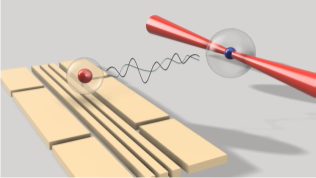Progress Report
Fault-tolerant Quantum Computing with Photonically Interconnected Ion Traps[7] Development of quantum interfaces between ions and atoms
Progress until FY2024
1. Outline of the project
Linking remote ion-trap modules is key ingredient for scaling the number of ion qubits towards large-scale fault-tolerant quantum computation. A technology for coupling a single ion to a different quantum system is indispensable for this purpose. In this research project, we develop a quantum interface for ions and neutral atoms based on Rydberg excitation. We aim to use ultracold atoms as a mobile qubit transmitter which enables connection between remote ion qubits. We expect that such a quantum interface for a hybrid quantum system offer a novel strategy for scaling the ion qubits in a more efficient and flexible way.

2. Outcome so far
We have worked on preparation of Rydberg atoms towards developing quantum interface between trapped ions and ultracold neutral atoms. Excitation of trapped ions and atoms to Rydberg states with large dipole moment expected to lead fast quantum gate operation by enhancing the atom-ion interaction. To prepare strontium atoms in the target Rydberg state, two ultraviolet laser beams were used.

Fig 2 shows the results obtained in this work. We confirmed that excitation to nD Rydberg series with principal quantum number n ranging from 30 to 100 were possible. The interpolated figure shows one example of the obtained Rydberg spectrum.
In order to control the atomic and ionic quantum state with high precision, it is necessary to cool atoms and ions in an ultracold regime. To this end, we implemented narrow-line laser cooling of strontium using an inter-combination transition. The final temperature of atoms reaches below 10 micro Kelvin where motional effect of the particles is strongly suppressed during quantum state manipulation.
In parallel, we developed an ultra-violet laser source for excitation of a single trapped ion in a Paul trap to Rydberg state. The laser system consists of a master oscillator power amplifier and two stages of second harmonic generation. By using this system, laser emission at a wavelength of 244 nm is obtained. We also identified the intermediate level for reaching Rydberg state via two-photon spectroscopy.
3. Future plans
In the next step, we will work on quantum state manipulation of trapped ions and neutral atoms towards implementation of quantum gate operations. In project, we are particularly interested in entangling schemes of an ion and an atom using Rydberg excitation. This is expected to be essential for hybridizing two different types of qubits based on trapped ions and neutral atoms and we aim to apply these technologies in quantum computation using ions and atoms.